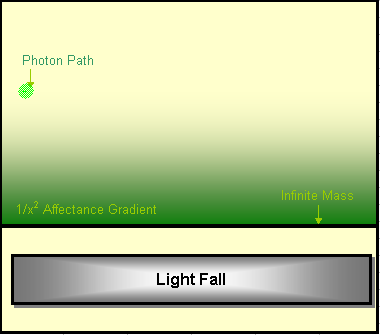RM:Affectance Ontology has a photon of light as what could be called a “puff of affectance”. In contemporary physics terms, affectance is ultra minuscule electromagnetic pulses. When those pulses are randomly directed, they constitute a mass or gravity field. When they are uniformly directed, they are observed as a “photon of electromagnetic radiation”. A photon is merely a puff of gravitational field energy or a puff of extremely low concentrated mass.
They debate the issue of whether a photon is a wave or a particle because such an affectance puff would at times seem as either. There is not an actual sinusoidal wave, like you see in diagrams. A photon comes closer to being a tiny cloud than a wave. And those clouds can be combined such as to behave much like an ocean wave. Of course, once combined, the many clouds are not longer many, but rather one oddly shaped traveling cloud that can produce a variety of effects.
A crude diagrammatic image of a photon:

Photons don’t actually have a true, physical wavelength as such. They have what is effectively a wavelength. They might as well have a wavelength for all practical purposes in physics (almost). They do have an overall length and width but those features can change dramatically without altering the energy content or assigned “wavelength”. Merely reflecting a photon off of a mirrored surface alters its physical shape. The density of the puff of affectance can be greater or lesser and thus produce higher or lower energy photons. If such puffs were to be compressed sufficiently, they would become tiny mass particles (“neutrinos”) traveling as extreme speeds. People experience colors because of the energy requirements of their variety of optic cells.
Such tiny puffs of electromagnetic affectance get produced most often by atoms as electrons drop their orbit distance around the nucleus. The affectance squirts out from between the electron and the nucleus in a straight line as a short puff traveling at light speed. The fact that most of the energy of the minuscule pulses is traveling in almost exactly same direction causes the pulses to stay together and thus seem much like a “particle”. And in addition, if touching and not running into too much randomizing interference from the ambient field, such minuscule pulses will inherently migrate a little closer to each other although cannot increase their individual density of affectance pulses. Affectance adheres to affectance. This allows such tiny little puffs to bend around objects without dissipating as if they were a true “solid” particle.

The speed of travel of these photons (the “speed of light”) depends upon the density of their ambient affectance (“mass/gravity field”). When traveling near massive objects where the mass field is strong, they travel slower. The tiny portion of each photon that is closer to the object travels a tiny bit slower than the rest of the photon and thus causes the photon puff to gradually veer toward the direction of the object. In contemporary physics, this effect is called “gravitational lensing” and depicted below as a light source passes behind a black-hole:

The higher density photons are more greatly affected by higher density mass fields and thus bend more strongly. When photons travel through materials, such as glass, they are close enough to the mass particles to be strongly affected and thus bend their travel course into the greater density material. Prisms will cause the separation of the higher density portions of affectance from the lower as the puffs pass through and thereby separate the colors/densities.
The speed of propagation of a photon through a simple ambient field (void of winds and gradients) can be calculated from the combined densities of the photon and the ambient field:
C = (1- (ad0+ad1) / (1 + ad0*ad1))
wherein C is the speed of the photon, ad0 is the affectance density of the ambient field (the “mass field”), and ad1 is the affectance density of the photon (its “color”). Note the when they refer to a “constant speed of light”, they are referring to the “constant speed of light in a truly absolute vacuum” of nothingness (which can’t ever actually exist).

